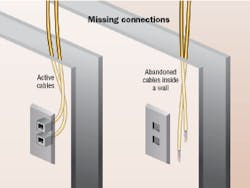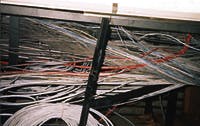Write the removal of abandoned cable into an RFQ. Bring the prospect of cable removal to established customers, and be forceful when you bring up the topic to a new customer. That's the strategic advice from cabling contractors who are trying to get a grip on the business of removing abandoned cable.
While removal was mandated by the National Electrical Code (NEC) three years ago, it has not made a significant difference in additional business for many contractors-yet. NEC 2002 contains seven definitions for abandoned cable, and says it should not be permitted to remain in a building due in part to fire hazard. Although some contractors think the Code lacks authority, that inspectors are lax about enforcing it, and building owners are either ignorant of the mandate or reluctant to pay for cable removal, there's an overriding call for stepped up education efforts to reach building owners, inspectors, and even contractors who are not familiar with what the Code says.
"I think the area of abandoned cable is really a concern now-much greater a concern for the building owners because someone will have to pay for it," says Ray Craig, BICSI (www.bicsi.org) regional director for the South Central Region.
John Pryma, director of structured cabling, Honeywell Cable Products (Morristown, NJ; www.honeywell.com), acknowledges that building owners have more to worry about than fire consuming abandoned cable, since a fire will first hit carpets and wooden furniture, and cables are generally the last thing to burn. Still, Pryma says it is simply a matter of good housekeeping and organization for building owners and institutions to remove abandoned cable. "If those cables are obsolete, you pull those old cables out; that way, you've got only active cables in the system," he says.
Abandoned cable can easily be found in hospitals, schools or other institutions that were built many ago, and then expanded in recent years. The removal of this cable in retrofit installations would seem to be something that would generate a lot of work for contractors. "The assumption was that (NEC) Code was going to make it like day and night; that abandoned cable would have to be removed," says Lee Nimmo, director of infrastructure services for Applied Logics, Inc. (Tampa, FL; www.appliedlogics.com). "Everyone was expecting a windfall, and that windfall never came."
Health care opportunities
But Mike Albanese, operations manager for Morgan Technology Inc. (Lakeland, FL; www.morgantechnology.com), says his team has removed abandoned cable in nearly 90% of their installations during the past year. One reason is that his team often conducts installations for the healthcare industry, where abandoned cable abounds and safety concern is a priority.
Albanese says that when the Code changed in 2002, end users who learned about the abandoned cable mandate were reluctant at first. But today, Albanese says all he has to do is point out that the cable needs to be removed, and he is given the green light to do the work. "We haven't had that much resistance," says Albanese.
"This is a revenue generator for cabling contractors, especially in this market. You'd think people would go out and contact these building owners and say, 'According to this new Code, abandoned cable must be removed, and I can remove all the abandoned cable,'" says BICSI's Craig.
Overcoming lost opportunities
Many contractors, in fact, have hoped that abandoned cable removal would be a kind of gold rush, and would help them make up for lost work during the past three years.
"I'd say we haven't seen a whole lot of movement either way," says Nimmo. "We thought this was a windfall, and that more activity and work would be generated. But it hasn't materialized."
But educating and taking creative initiative are the keys to overcoming such lost opportunities, many suggest. Nimmo claims the wording of the Code is not clear about what should and shouldn't be removed, or when-and that leads to difficulty in enforcement. "It's pretty loose," says Nimmo. "It gives end users a loophole."
"The Code language is fine," counters Mike Holt of Mike Holt Enterprises (Tamarac, FL; www.mikeholt.com) and an NEC representative. "It's at the enforcement level where it breaks down."
But Albanese of Morgan Technology believes that with each passing day, awareness is increasing. "The inspectors are being more diligent about it, so it's just coming into its own right now."
Craig agrees that contractors, too, are more aware of abandoned cable issues, with many of them having been informed through BICSI training. "It's whether they are taking advantage of the opportunities-that's where there is an unknown," he says.
If there is lack of awareness among end users, Craig adds, the onus is on the contractor to explain to building owners what the NEC has to say about removing abandoned cable.
Put it in writing
Albanese believes contractors will find more abandoned cable removal business if they will simply become more aggressive in their approach. Most customers, he says, need to be made aware of the necessity of removing abandoned cable. "We include it (cable removal) in the quotes," says Albanese. "We are telling end users that they have abandoned cable and need to get rid of it because the NEC is requiring this sort of thing."
Another key to success: Establish a relationship with your customers.
Nimmo says he has found success in convincing established customers to have abandoned cable removed because they felt the contractor was looking out for their best interest rather than simply giving them a sales pitch. In short, they trusted them. He recalls approaching representatives from a large regional hospital in Zephyr Hills, FL for which his team had previously installed a lot of cable. Nimmo says he met the manager with whom he had worked previously, and spoke with him about the need to remove abandoned cable in the walls.
"I explained that an inspector could penalize them for breach of Code," says Nimmo. "They've gone from one generation to another and left it (cable) in the ceiling. Everything was still working, so from a business incentive, there was no incentive to address it," other than because of the trust in the established relationship.
For the new customer with abandoned cable that needs to be removed, the challenge to overcome is that cable removal is an unbudgeted, unprojected expense. Here, Albanese says contractors will have greater opportunity for success by simply working abandoned cable removal into an RFQ. "It's making everyone aware," he says.


